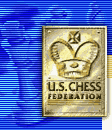Let's Play Chess
Chess is a game for two players, one with the "White" pieces and one
with the "Black" pieces. At the beginning of the game, the pieces are
set up as pictured at right. (See diagrams below to identify pieces.)
These hints will help you to remember the proper board setup:
- Opposing Kings and Queens go directly opposite each other.
- The square in the lower right hand corner is a light one ("light on right").
- The White Queen goes on a light square, the Black Queen on a dark square ("Queen on color").
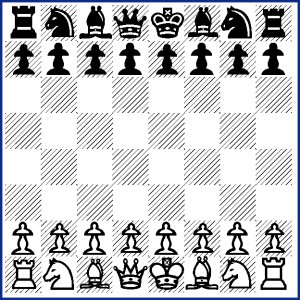
White always moves first, and then the players take turns moving.
Only one piece may be moved at each turn (except for "castling," a
special move that is explained later). The Knight is the only piece
that can jump over other pieces. All other pieces move only along
unblocked lines. You may not move a piece to a square already occupied
by one of your own pieces. But you can capture an enemy piece that
stands on a square where one of your pieces can move. Simply remove the
enemy piece from the board and put your own piece in its place.
The Pieces and How They Move
The Queen
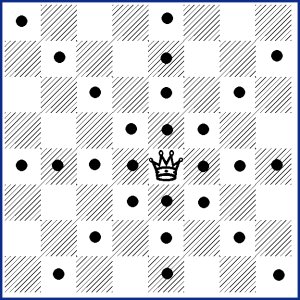
The Queen is the most powerful piece. She can move any number of
squares in any direction — horizontal, vertical, or diagonal — if her
path is not blocked. She can reach any of the squares with dots in this
diagram.
The Rook
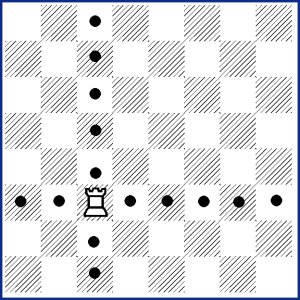
The Rook is the next most powerful piece. The Rook can move any
number of squares vertically or horizontally if its path is not blocked.
The Bishop
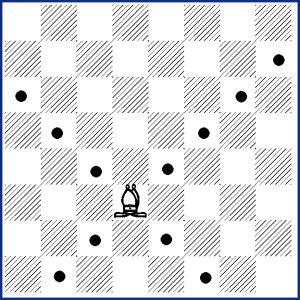
The Bishop can move any number of squares diagonally if its path is
not blocked. Note that this Bishop starts on a light square and can
reach only other light squares. At the beginning of the game, you have
one "dark-square" Bishop and one "light-square" Bishop.
The Knight
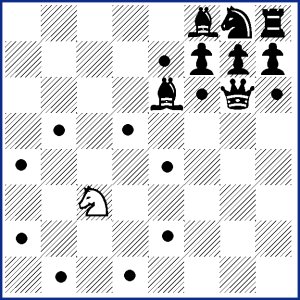
The Knight's move is special. It hops directly from its old square
to its new square. The Knight can jump over other pieces between its
old and new squares. Think of the Knight's move as an "L." It moves two
squares horizontally or vertically and then makes a right-angle turn
for one more square. The Knight always lands on a square opposite in
color from its old square.
The King
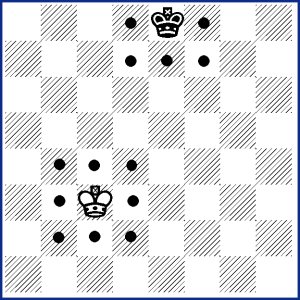
The King is the most important piece. When he is trapped, his whole
army loses. The King can move one square in any direction — for
example, to any of the squares with dots in this diagram. (An exception
is castling, which is explained later.) The King may never move into
check — that is, onto a square attacked by an opponent's piece.
The Pawn
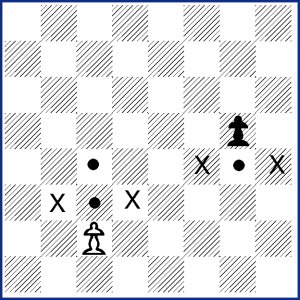
The pawn moves straight ahead (never backward), but it captures
diagonally. It moves one square at a time, but on its first move it has
the option of moving forward one or two squares. In the diagram, the
squares with dots indicate possible destinations for the pawns. The
White pawn is on its original square, so it may move ahead either one
or two squares. The Black pawn has already moved, so it may move ahead
only one square at a time. The squares on which these pawns may capture
are indicated by an X.
If a pawn advances all the way to the opposite end of the board, it
is immediately "promoted" to another piece, usually a Queen. It may not
remain a pawn or become a King. Therefore, it is possible for each
player to have more than one Queen or more than two Rooks, Bishops, or
Knights on the board at the same time.
Special Moves
Castling
Each player may "castle" only once during a game and when conditions
are met. Castling is a special move that lets a player move two pieces
at once — the King and one Rook. In castling, the player moves his King
two squares to its left or right toward one of his Rooks. At the same
time, the Rook involved goes to the square beside the King and toward
the center of the board (see illustrations below). In order to castle,
neither the King nor the Rook involved may have moved before. Also, the
King may not castle out of check, into check, or through check.
Further, there may not be pieces of either color between the King and
the Rook involved in castling.
Castling is often a very important move because it allows you to
place your King in a safe location and also allows the Rook to become
more active.
When the move is legal, each player has the choice of castling
Kingside or Queenside or not at all, no matter what the other player
chooses to do.
| The diagrams below show what happens: |
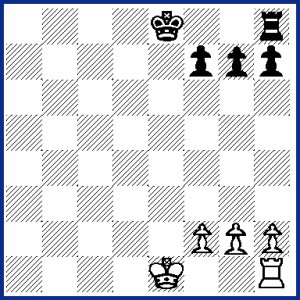
Before Kingside Castling | 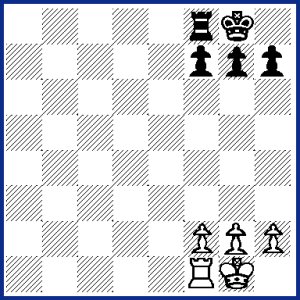
After Kingside Castling |
| |
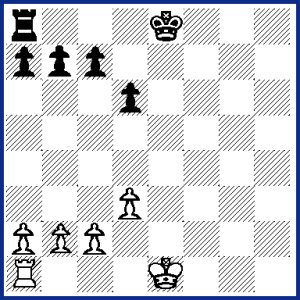
Before Queenside Castling | 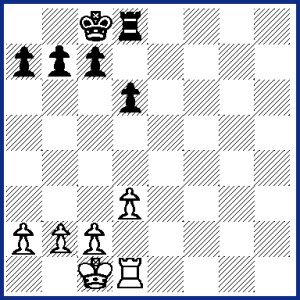
After Queenside Castling |
En Passant
This French phrase is used for a special pawn capture. It means "in
passing," and it occurs when one player moves a pawn two squares
forward to try to avoid capture by the opponent's pawn. The capture is
made exactly as if the player had moved the pawn only one square
forward.
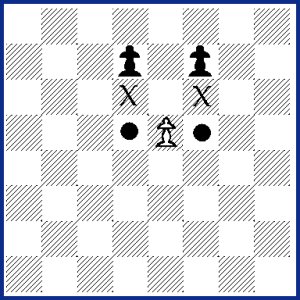
In the diagram, the Black pawn moves up two squares to the square
with the dot. On its turn the White pawn may capture the Black one on
the square marked with the X. If the White player does not exercise
this option immediately — before playing some other move — the Black
pawn is safe from "en passant" capture for the rest of the game. But
new opportunities may arise for each pawn in similar circumstances.
About Check and Checkmate
The main goal of chess is to checkmate your opponent's King. The
King is not actually captured and removed from the board like other
pieces. But if the King is attacked ("checked") and threatened with
capture, it must get out of check immediately. If there is no way to
get out of check, the position is a "checkmate," and the side that is
checkmated loses.
You may not move into check. For example, moving into a direct line
with your opponent's Rook, when if there are no other pieces between
the Rook and your King, is not a legal move. Otherwise, the Rook could
"capture" the King, which is not allowed.
If you are in check, there are three ways of getting out:
- Capturing the attacking piece;
- Placing one of your own pieces between the attacker and your King (unless the attacker is a Knight);
- Moving the King away from the attack.
If a checked player can do none of these, he is checkmated and loses the game.
If a King is not in check, but that player can make no legal move,
the position is called a stalemate and the game is scored as a draw, or
tie.
|
